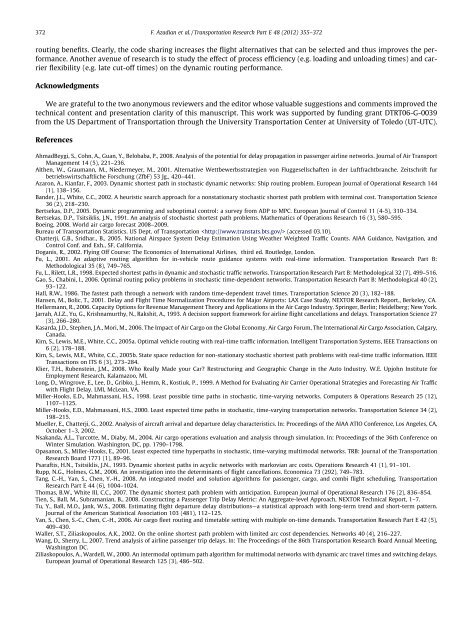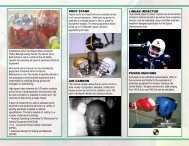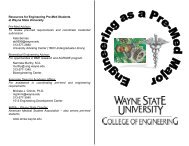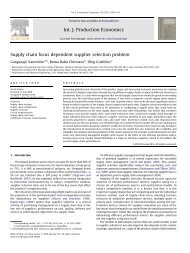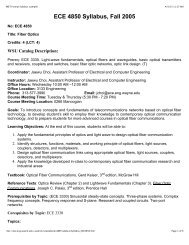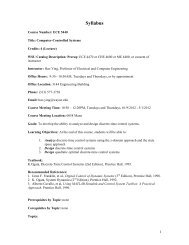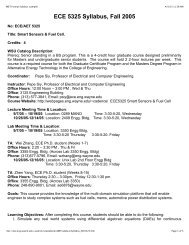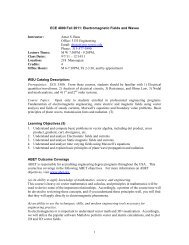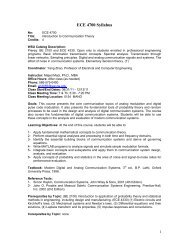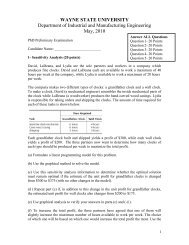Dynamic routing of time-sensitive air cargo using real-time information
Dynamic routing of time-sensitive air cargo using real-time information
Dynamic routing of time-sensitive air cargo using real-time information
- No tags were found...
Create successful ePaper yourself
Turn your PDF publications into a flip-book with our unique Google optimized e-Paper software.
372 F. Azadian et al. / Transportation Research Part E 48 (2012) 355–372<strong>routing</strong> benefits. Clearly, the code sharing increases the flight alternatives that can be selected and thus improves the performance.Another avenue <strong>of</strong> research is to study the effect <strong>of</strong> process efficiency (e.g. loading and unloading <strong>time</strong>s) and carrierflexibility (e.g. late cut-<strong>of</strong>f <strong>time</strong>s) on the dynamic <strong>routing</strong> performance.AcknowledgmentsWe are grateful to the two anonymous reviewers and the editor whose valuable suggestions and comments improved thetechnical content and presentation clarity <strong>of</strong> this manuscript. This work was supported by funding grant DTRT06-G-0039from the US Department <strong>of</strong> Transportation through the University Transportation Center at University <strong>of</strong> Toledo (UT-UTC).ReferencesAhmadBeygi, S., Cohn, A., Guan, Y., Belobaba, P., 2008. Analysis <strong>of</strong> the potential for delay propagation in passenger <strong>air</strong>line networks. Journal <strong>of</strong> Air TransportManagement 14 (5), 221–236.Althen, W., Graumann, M., Niedermeyer, M., 2001. Alternative Wettbewerbsstrategien von Fluggesellschaften in der Luftfrachtbranche. Zeitschrift furbetriebswirtschaftliche Forschung (ZfbF) 53 Jg., 420–441.Azaron, A., Kianfar, F., 2003. <strong>Dynamic</strong> shortest path in stochastic dynamic networks: Ship <strong>routing</strong> problem. European Journal <strong>of</strong> Operational Research 144(1), 138–156.Bander, J.L., White, C.C., 2002. A heuristic search approach for a nonstationary stochastic shortest path problem with terminal cost. Transportation Science36 (2), 218–230.Bertsekas, D.P., 2005. <strong>Dynamic</strong> programming and suboptimal control: a survey from ADP to MPC. European Journal <strong>of</strong> Control 11 (4-5), 310–334.Bertsekas, D.P., Tsitsiklis, J.N., 1991. An analysis <strong>of</strong> stochastic shortest path problems. Mathematics <strong>of</strong> Operations Research 16 (3), 580–595.Boeing, 2008. World <strong>air</strong> <strong>cargo</strong> forecast 2008–2009.Bureau <strong>of</strong> Transportation Statistics. US Dept. <strong>of</strong> Transportation (accessed 03.10).Chatterji, G.B., Sridhar., B., 2005. National Airspace System Delay Estimation Using Weather Weighted Traffic Counts. AIAA Guidance, Navigation, andControl Conf. and Exh., SF, California.Doganis, R., 2002. Flying Off Course: The Economics <strong>of</strong> International Airlines, third ed. Routledge, London.Fu, L., 2001. An adaptive <strong>routing</strong> algorithm for in-vehicle route guidance systems with <strong>real</strong>-<strong>time</strong> <strong>information</strong>. Transportation Research Part B:Methodological 35 (8), 749–765.Fu, L., Rilett, L.R., 1998. Expected shortest paths in dynamic and stochastic traffic networks. Transportation Research Part B: Methodological 32 (7), 499–516.Gao, S., Chabini, I., 2006. Optimal <strong>routing</strong> policy problems in stochastic <strong>time</strong>-dependent networks. Transportation Research Part B: Methodological 40 (2),93–122.Hall, R.W., 1986. The fastest path through a network with random <strong>time</strong>-dependent travel <strong>time</strong>s. Transportation Science 20 (3), 182–188.Hansen, M., Bolic, T., 2001. Delay and Flight Time Normalization Procedures for Major Airports: LAX Case Study, NEXTOR Research Report., Berkeley, CA.Hellermann, R., 2006. Capacity Options for Revenue Management Theory and Applications in the Air Cargo Industry. Springer, Berlin; Heidelberg; New York.Jarrah, A.I.Z., Yu, G., Krishnamurthy, N., Rakshit, A., 1993. A decision support framework for <strong>air</strong>line flight cancellations and delays. Transportation Science 27(3), 266–280.Kasarda, J.D., Stephen, J.A., Mori, M., 2006. The Impact <strong>of</strong> Air Cargo on the Global Economy. Air Cargo Forum, The International Air Cargo Association, Calgary,Canada.Kim, S., Lewis, M.E., White, C.C., 2005a. Optimal vehicle <strong>routing</strong> with <strong>real</strong>-<strong>time</strong> traffic <strong>information</strong>. Intelligent Transportation Systems, IEEE Transactions on6 (2), 178–188.Kim, S., Lewis, M.E., White, C.C., 2005b. State space reduction for non-stationary stochastic shortest path problems with <strong>real</strong>-<strong>time</strong> traffic <strong>information</strong>. IEEETransactions on ITS 6 (3), 273–284.Klier, T.H., Rubenstein, J.M., 2008. Who Really Made your Car? Restructuring and Geographic Change in the Auto Industry. W.E. Upjohn Institute forEmployment Research, Kalamazoo, MI.Long, D., Wingrove, E., Lee, D., Gribko, J., Hemm, R., Kostiuk, P., 1999. A Method for Evaluating Air Carrier Operational Strategies and Forecasting Air Trafficwith Flight Delay. LMI, McLean, VA.Miller-Hooks, E.D., Mahmassani, H.S., 1998. Least possible <strong>time</strong> paths in stochastic, <strong>time</strong>-varying networks. Computers & Operations Research 25 (12),1107–1125.Miller-Hooks, E.D., Mahmassani, H.S., 2000. Least expected <strong>time</strong> paths in stochastic, <strong>time</strong>-varying transportation networks. Transportation Science 34 (2),198–215.Mueller, E., Chatterji, G., 2002. Analysis <strong>of</strong> <strong>air</strong>craft arrival and departure delay characteristics. In: Proceedings <strong>of</strong> the AIAA ATIO Conference, Los Angeles, CA,October 1–3, 2002.Nsakanda, A.L., Turcotte, M., Diaby, M., 2004. Air <strong>cargo</strong> operations evaluation and analysis through simulation. In: Proceedings <strong>of</strong> the 36th Conference onWinter Simulation. Washington, DC, pp. 1790–1798.Opasanon, S., Miller-Hooks, E., 2001. Least expected <strong>time</strong> hyperpaths in stochastic, <strong>time</strong>-varying multimodal networks. TRB: Journal <strong>of</strong> the TransportationResearch Board 1771 (1), 89–96.Psaraftis, H.N., Tsitsiklis, J.N., 1993. <strong>Dynamic</strong> shortest paths in acyclic networks with markovian arc costs. Operations Research 41 (1), 91–101.Rupp, N.G., Holmes, G.M., 2006. An investigation into the determinants <strong>of</strong> flight cancellations. Economica 73 (292), 749–783.Tang, C.-H., Yan, S., Chen, Y.-H., 2008. An integrated model and solution algorithms for passenger, <strong>cargo</strong>, and combi flight scheduling. TransportationResearch Part E 44 (6), 1004–1024.Thomas, B.W., White III, C.C., 2007. The dynamic shortest path problem with anticipation. European Journal <strong>of</strong> Operational Research 176 (2), 836–854.Tien, S., Ball, M., Subramanian, B., 2008. Constructing a Passenger Trip Delay Metric: An Aggregate-level Approach, NEXTOR Technical Report, 1–7.Tu, Y., Ball, M.O., Jank, W.S., 2008. Estimating flight departure delay distributions—a statistical approach with long-term trend and short-term pattern.Journal <strong>of</strong> the American Statistical Association 103 (481), 112–125.Yan, S., Chen, S.-C., Chen, C.-H., 2006. Air <strong>cargo</strong> fleet <strong>routing</strong> and <strong>time</strong>table setting with multiple on-<strong>time</strong> demands. Transportation Research Part E 42 (5),409–430.Waller, S.T., Ziliaskopoulos, A.K., 2002. On the online shortest path problem with limited arc cost dependencies. Networks 40 (4), 216–227.Wang, D., Sherry, L., 2007. Trend analysis <strong>of</strong> <strong>air</strong>line passenger trip delays. In: The Proceedings <strong>of</strong> the 86th Transportation Research Board Annual Meeting,Washington DC.Ziliaskopoulos, A., Wardell, W., 2000. An intermodal optimum path algorithm for multimodal networks with dynamic arc travel <strong>time</strong>s and switching delays.European Journal <strong>of</strong> Operational Research 125 (3), 486–502.


